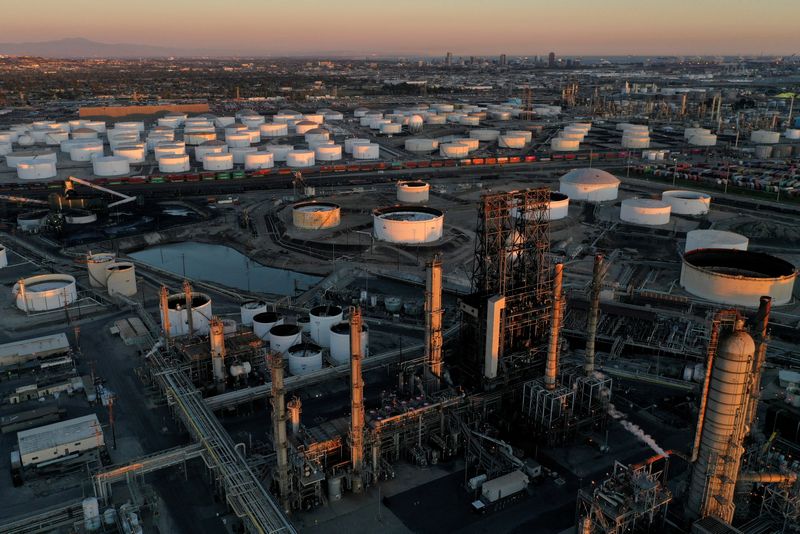By Shariq Khan, Mohi Narayan and Ahmad Ghaddar
NEW YORK/NEW DELHI/LONDON (Reuters) - Oil refiners are making less money selling their gasoline as demand during the peak summer driving season has fallen short of what they expected when many of them boosted production.
Softness in gasoline markets have upended years of record profits on selling transportation fuels. In the U.S., the world's largest gasoline market, refiners ramped up sharply, expecting demand that never materialized. U.S. gasoline demand was 9 million barrels per day (bpd) in the first week of June, 1.7% below last year and seasonally the lowest since 2021, government data showed.
In Asia, weakness in the gasoline market has already led to run cuts, and refiners elsewhere are also likely to pull back in weeks ahead. This could reduce global demand for crude oil.
"Given the retreat from elevated margins, we cite risk to refiners' continued maximum output strategy to reap record profits," BMI, a unit of Fitch Solutions, said in a note last month.
Brent oil prices are down about 9% from a mid-April peak to around $83 a barrel, most recently on concerns that the OPEC+ producer group will add supply to the market. The producer group last week warned that a slow start to the summer driving season and low margins are weighing on sentiment.
Even with crude prices slipping, Asian refiners' profit on making gasoline from a barrel of Brent halved in the last week of May to about $4 per barrel. A glut of fuel supplies prompted the fall in refining margins, Wood Mackenzie analyst Priti Mehta said.
Overall refining margins fell under $2 a barrel in Singapore in May, compared with an average of $5 a year ago.
European gasoline refining margins fell to $10.80 a barrel on June 13, the lowest since January 25. U.S. gasoline crack spread, the difference between gasoline futures and the cost of WTI crude oil, was under $22.50 a barrel for the first time since February.
PULLBACK
Taiwan's Formosa Petrochemical Corp, one of Asia's largest refined products exporters, plans to cut run rates at its crude distillation units in June to 440,000 bpd, down 40,000 bpd from its original plan to process 480,000 bpd.
"Increased flows from the Middle East to Asia and increased Indian exports are weakening the cracks, otherwise demand in Asia is healthy," a spokesperson for Formosa told Reuters.
U.S. demand has been pressured by a mix of factors, including more people flying instead of driving long distances and more fuel-efficient cars and electric vehicles, UBS analyst Giovanni Staunovo said last month.
Higher output from American refineries, combined with weak demand, has lifted U.S. gasoline stockpiles by 5.7 million barrels since the start of April to 233.5 million barrels by June 7, the highest for this time since 2021.
U.S. refiners cut run-rates to 95% in the week ended June 7, after utilizing a one-year high of 95.4% in the prior week, U.S. Energy Information Administration (EIA) data showed. That was the first cut since April.
They will need to lower rates further if demand remains lackluster, Mizuho analyst Robert Yawger said.
"We're looking at the potential for one of the worst years for summer U.S. gasoline demand in the post-COVID world. No way that refiners can continue to crank fuels at 95% utilization," he said.
The EIA on Tuesday lowered its forecast for U.S. gasoline consumption this year to 8.89 million bpd from an earlier estimate of 8.91 million.
OVERWHELMING SUPPLY
Margins should improve as U.S. gasoline rises as it typically does throughout the summer, Rabobank strategist Joe DeLaura said. Yet he warned the market has consistently underperformed.
Margins should get some support from a slower-than-expected ramp up of new refineries such as Mexico's Olmeca refinery in Dos Bocas, which is aiming to lower the country's import needs. As of May, however, Dos Bocas was behind schedule and did not produce commercially viable gasoline and diesel. In Nigeria, the Dangote refinery delayed gasoline deliveries until July.
The market must still adjust to overwhelming supply growth from new refineries ramping up and expansions of existing plants which have boosted fuel exports from the Middle East, India and China.
Gasoline exports from the Middle East have been at seasonal records over the last six months, according to Kpler data.
Indian and Chinese refiners are taking advantage of access to discounted Russian oil, Mehta said. Their higher supplies are likely to keep Asian gasoline cracks under pressure through the summer, she said.

"The peak for gasoline (cracks) was already reached in April, when cracks averaged $17.3/bbl Dubai crude in Asia. We don't expect them to strengthen a lot through the summer period," Mehta said.
Chinese gasoline exports grew by about 100,000 bpd in May from April, ending last month at around 350,000 bpd, according to WoodMac. Indian gasoline exports averaged 360,000 bpd in May, up 50,000 bpd on the month.